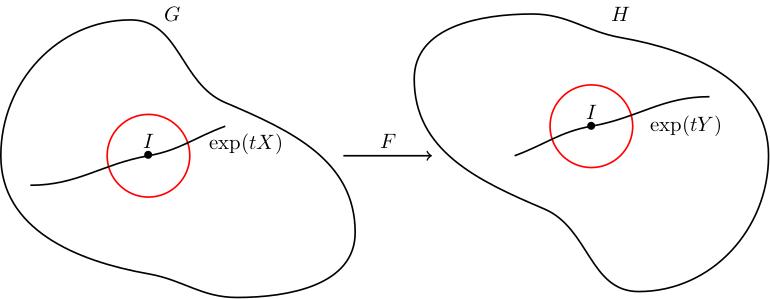If is a smooth homomorphism of matrix groups and denotes the locally-defined map then:
-
is the restriction of a linear map to a neighbourhood of .
-
for all ,
-
for all and in .
In this video, we will prove the following theorem which was stated earlier:
If is a smooth homomorphism of matrix groups and denotes the locally-defined map then:
is the restriction of a linear map to a neighbourhood of .
for all ,
for all and in .
Our first observation is that, for all , is a 1-parameter subgroup. Since is a smooth homomorphism, and since a 1-parameter subgroup is just a smooth homomorphism from , we deduce that is a 1-parameter subgroup in . By what we proved about 1-parameter subgroups, for some .

The figure above shows the groups and , the paths and , and (red) neighbourhoods of the identity in each on which the logarithm is well-defined. For small , and are both close to the identity, so live in the domain of the local logarithm.
We have for small and for all . Therefore, for small we can take logarithms and deduce that .
Since is a smooth map, we can take the Taylor series , where is the derivative of at . Because , we see that and all higher order terms vanish.
This means that for all and all sufficiently small . Therefore on the domain of the exponential chart. We take . This proves the first part of the theorem. Recall that the matrix for the linear map is the matrix of partial derivatives of components of ,
The second part follows from what we have already said: we showed that (for all ), and . Setting we get .
To prove the final part of the theorem, consider the expression Use the Baker-Campbell-Hausdorff formula to multiply the first two and last two terms together and we get Using the Baker-Campbell-Hausdorff formula to multiply these two together, after a little manipulation, we get
If I apply to this whole expression, we get: by definition of .
Because is a homomorphism, By definition of , this equals and using the Baker-Campbell-Hausdorff formula in the same way we get
If we take small then we can take logarithms and we get Differentiating twice and setting we get as required.